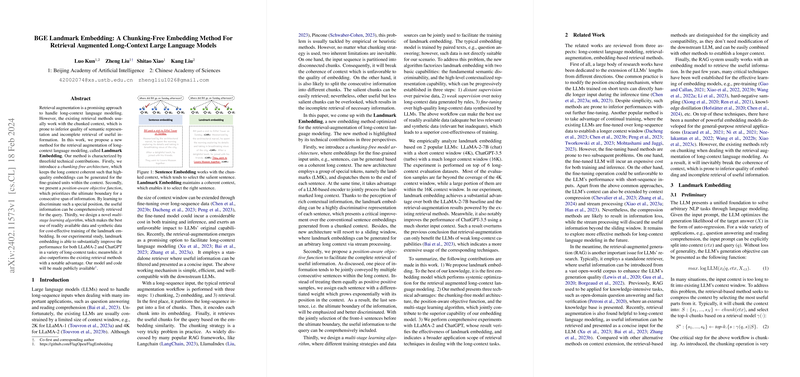Enhancing Retrieval-Augmented LLMing with BGE Landmark Embedding
Introduction
The paper introduces BGE Landmark Embedding, an innovative approach designed to enhance retrieval-augmented LLMing for long-context LLMs. Amidst the challenges of handling long-sequence inputs essential for complex applications like question answering and reading comprehension, LLMs often grapple with the limitations of context window sizes. BGE Landmark Embedding emerges as a paradigm that not only bypasses the traditional chunking necessity but also pioneers a chunking-free embedding strategy for superior semantic representation. This approach is delineated through its remarkable enhancement of LLM performance across various long-context tasks and notable outperformance over existing retrieval methods.
Technical Contributions
A trio of technical contributions underpins the core novelty of the BGE Landmark Embedding method:
- Chunking-Free Model Architecture: The introduction of a chunking-free architecture allows for high-quality embeddings by maintaining the long context's coherence. Special tokens, termed landmarks, are leveraged to facilitate this process alongside a LLM-based encoder for comprehensive processing.
- Position-Aware Objective Function: This novel objective function accentuates the importance of the ultimate boundary within a consecutive span of information, driving the comprehensive retrieval of pertinent data with heightened emphasis on the sequence's termination point.
- Multi-Stage Learning Algorithm: A bespoke learning algorithm unfolds across multiple stages, optimizing the utilization of available data. This phased approach stresses progressively enhancing the model's nuanced capabilities, from semantic discriminability to context-based representation, ensuring an optimal blend of cost-effectiveness in training.
Empirical Analysis
Through rigorous experimentation involving contemporary LLMs like LLaMA-2 and ChatGPT, BGE Landmark Embedding showcases its effectiveness by substantially improving performance across a variety of long-context tasks. This superiority extends not just in comparison to baseline model performances but also against other existing retrieval methodologies. The methodology delineates significant numerical advantages, proving its efficacy in real-world applications.
Implications and Future Directions
The paper's findings not only underscore the increased effectiveness and efficiency of leveraging BGE Landmark Embedding in retrieval-augmented LLMing tasks but also hint at broader implications for the future of AI. Speculatively, the approach could pave the way for advancements in LLMs’ capability to handle complex, nuanced queries over extensive informational contexts without compromising on performance or accuracy. Furthermore, the landmark embedding innovation could inspire further research into chunking-free architectures and refinements in objective function design, catering to an even wider array of applications within the AI domain.
Conclusion
BGE Landmark Embedding redefines the approach towards enhancing long-context understanding in LLMs through its unique, chunking-free embedding method. Its multifaceted contributions not only address but also effectively overcome the inherent challenges faced by existing models, marking a significant stride towards improved semantic representation and information retrieval. With its demonstrated advantages over conventional methodologies, BGE Landmark Embedding sets a new benchmark for future research and development in the field of generative AI and LLMs.
